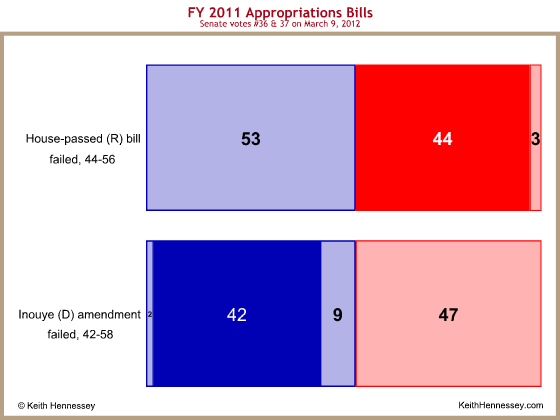Yesterday the Senate voted on competing proposals for discretionary spending for the remaining seven months of Fiscal Year 2011.
Republicans offered the House-passed bill, H.R. 1. Democratic leaders supported an alternative offered by Appropriations Committee Chairman Daniel Inouye.
Each proposal needed 60 votes to succeed. Both failed to get even a majority.
Here I show these two votes, with Senate Democrats (and the two Independents who caucus with Democrats) in blue and Senate Republicans in red. Heavy solid coloring represents an aye vote, while lightly shaded coloring represents a no vote. As always, you can click on a graph to see a larger version.
It is politically significant that, in a 53-47 Democratic Senate, the House-passed bill garnered more votes than the Senate Democratic alternative. That is a bad outcome for the Senate majority party.
On the House-passed bill, I have positioned the three no votes on the far right. It is clear that Republican Senators DeMint (SC), Lee (UT), and Paul (KY) voted no because they want even less spending than in H.R. 1, or at least to signal that they don’t want spending to increase above H.R. 1. On this issue the three of them are the right flank in the Senate
With the exception of those three, the vote on H.R. 1 was straight party line. I am pleasantly surprised that Republican moderates supported H.R. 1. House and Senate Republicans are at the moment united.
The Democratic alternative was an implementation of the President’s proposal. All 47 Republicans voted no, while Democrats split into three camps.
The bulk of the Democratic caucus, 42 members, supported Inouye.
Senators Levin (MI) and Sanders (I-VT) voted no on the left. I presume they thought the cuts in Inouye were too deep, or at least they were casting a symbolic vote that they didn’t want cuts to go deeper.
More interesting are the nine Democrats who voted no and are making public statements that I think position them right of Inouye. This group includes Senators Bennet (CO), Hagan (NC), Kohl (WI), Manchin (WV), McCaskill (MO), Bill Nelson (FL), Ben Nelson (NE), Mark Udall (CO), and Webb (VA).
The above pictures shows a stalemate. Without a deal between the leaders, each would struggle to get a simple majority, never mind the 60 votes needed for a victory. This may explain Senator McConnell’s quote this morning:
We’re waiting for the president of the United States. He is the most prominent Democrat in America — only his signature can make something a law. Now is the time to engage, and he has been curiously passive up to this point.
So far Senate Republicans are standing firm with their House colleagues, and Senate Democrats are splitting quite significantly. And while the Senate floor is, at the moment, the battleground, this is not just a Senate game. A hypothetical Senate deal could easily fail in the more partisan House, where both the average and marginal Republican votes are farther right. Since the Speaker unilaterally controls whether a bill can be considered on the House floor, the President and his team must gain Speaker Boehner’s support for any deal.
Late last week I predicted a final spending level at the midpoint of these two bills, but said it was quite possible there will be another CR before any final deal. Today I renew both parts of that prediction, with even a little more optimism that a final spending level will favor the House bill.
